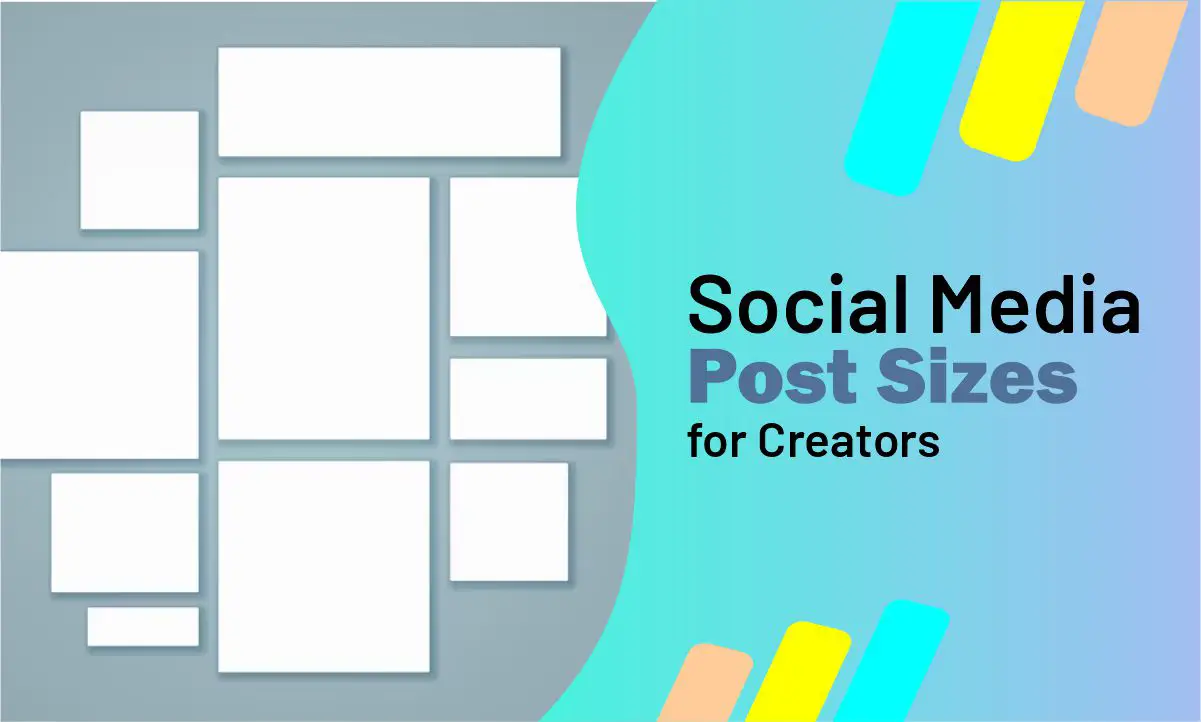Creating perfectly sized content for each social media platform is essential in 2025. With algorithms increasingly favoring native and optimized content, businesses, marketers, and creators need to understand the best dimensions for images, videos, and text. Whether you’re managing campaigns through tools or creating content manually, knowing the right sizes ensures your visuals look crisp and professional while delivering top engagement.
This comprehensive guide breaks down social media post sizes platform-by-platform, giving you an edge in maximizing visibility, engagement, and branding impact.
Quick Reference: 2025 Social Media Post Sizes Cheat Sheet
| Platform | Image Sizes | Video Sizes | Text Limits |
|---|---|---|---|
| 1200×630 (landscape), 1080×1080 (square) | 1280×720 (min), 1080×1920 (Reels) | 63,206 characters (post text) | |
| 1080×1080 (square), 1080×1350 (portrait) | 1080×1920 (Reels, Stories) | 2,200 characters (caption) | |
| 1200×627 (landscape), 1080×1080 (square) | Up to 4096×2304 | 3,000 characters (post) | |
| X (Twitter) | 1600×900 (landscape), 1080×1350 (portrait) | 1280×720 (video), 8GB file max | 25,000 characters (post) |
| Snapchat | 1080×1920 (vertical) | 1080×1920 (vertical, up to 3 mins) | 25 characters (caption) |
| TikTok | 1080×1920 (vertical) | Up to 60 mins (uploaded), 500MB file | 2,200 characters (caption) |
| BlueSky | 1200×675 (image) | 1280×720, 3 minutes max | 300 characters (post) |
| 1000×1500 (standard), 1000×2100 (long) | 1000×1500, up to 2GB | 500 characters (description) |
Facebook Post Sizes in 2025
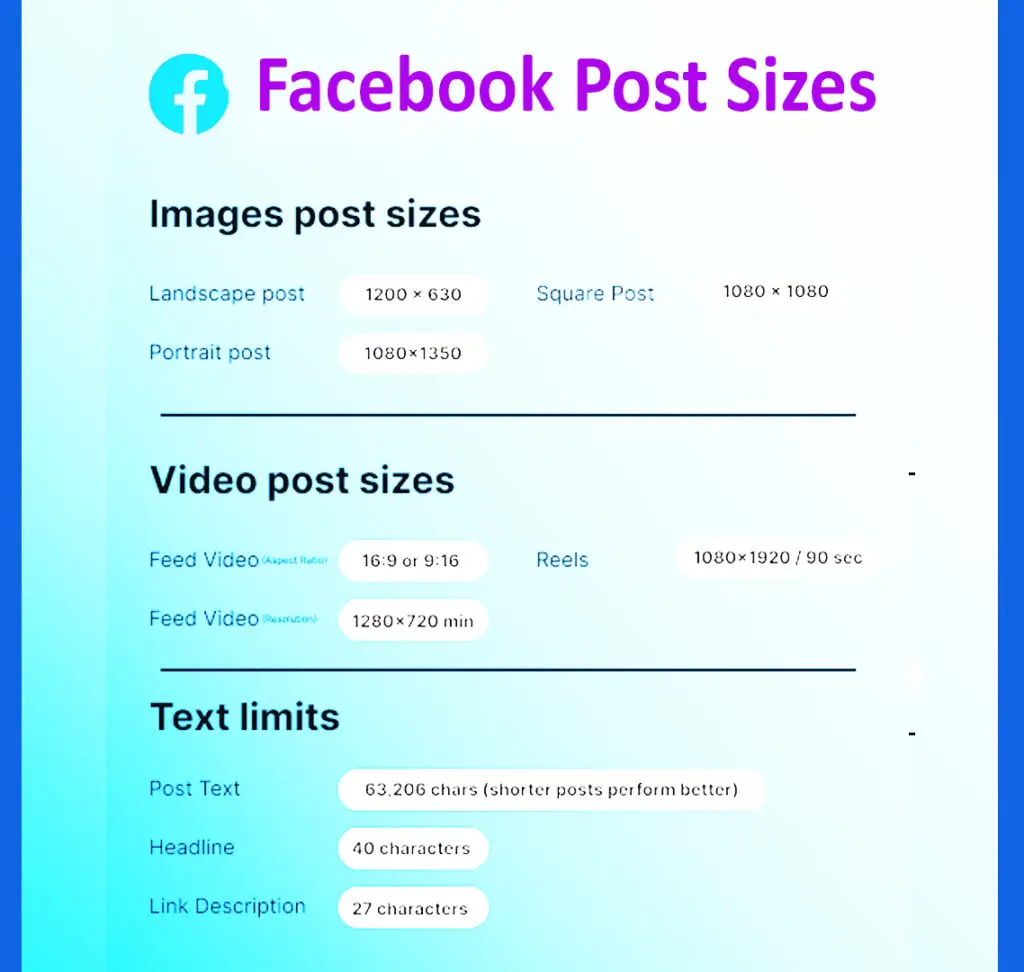
As one of the most established and versatile platforms with over 3 billion monthly users, Facebook supports a broad spectrum of media types. In 2025, engagement is driven by native uploads and mobile-optimized content.
Image Sizes
- Landscape Image: 1200 x 630 pixels (ideal for link shares)
- Square Image: 1080 x 1080 pixels
- Portrait Image: 1080 x 1350 pixels
Video Sizes
- Feed Video: Minimum 1280 x 720 pixels, 16:9 or 9:16 aspect ratio
- Reels: 1080 x 1920 pixels; length up to 90 seconds
- File Format: MP4 or MOV recommended
- Max Length: 240 minutes
Text Limits
- Post Text: Up to 63,206 characters
- Headline: 40 characters
- Link Description: 27 characters
Tips: Upload videos directly instead of sharing YouTube links to boost reach. Facebook favors content that keeps users within its ecosystem.
Instagram Post Sizes in 2025
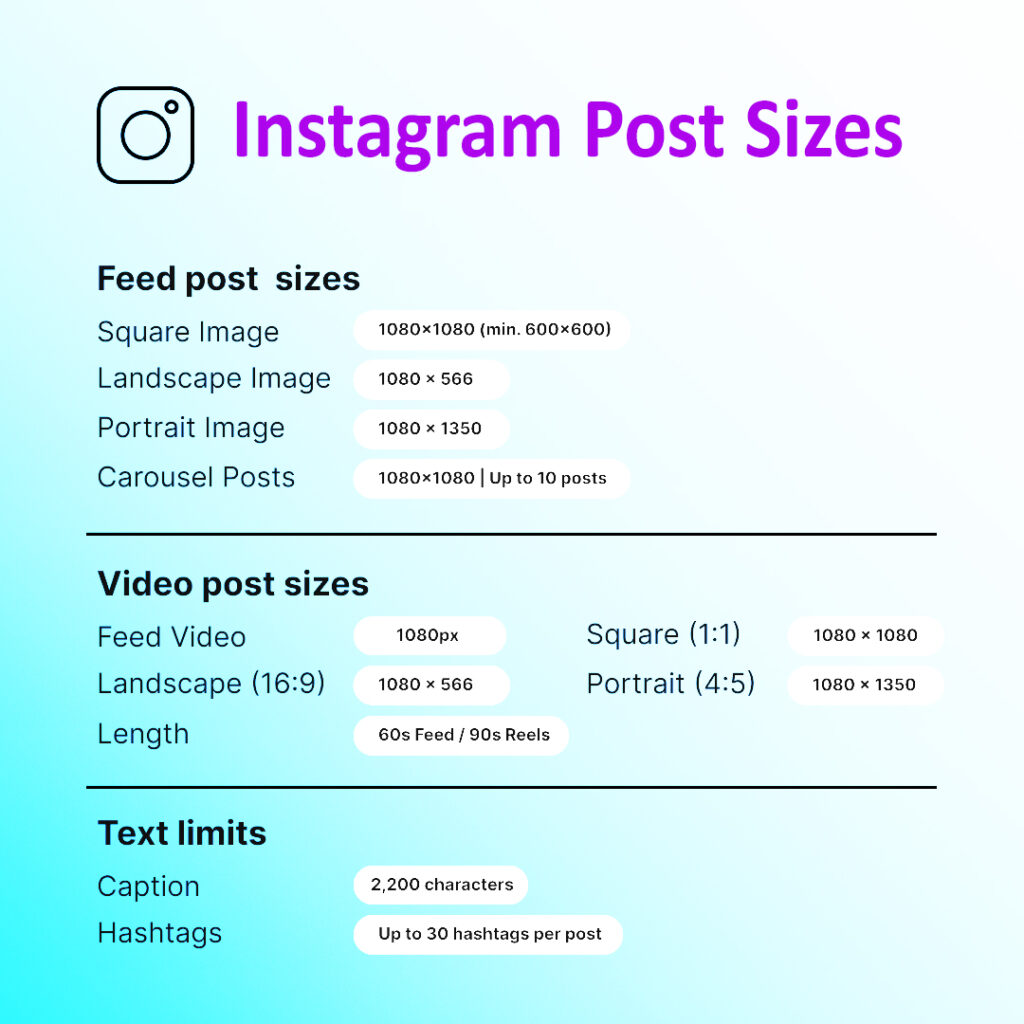
Instagram remains the go-to visual platform for lifestyle, fashion, food, and creators, boasting over 2 billion monthly users.
Image Sizes
- Square: 1080 x 1080 pixels
- Portrait: 1080 x 1350 pixels
- Landscape: 1080 x 566 pixels
- Carousel Posts: 1080 x 1080 pixels per image (up to 10 images or videos)
Video Sizes
- Feed Videos:
- Square: 1080 x 1080
- Portrait: 1080 x 1350
- Landscape: 1080 x 566
- Reels: 1080 x 1920 pixels, up to 90 seconds
Text Limits
- Caption: 2,200 characters
- Hashtags: Maximum 30 per post (recommended: 7–11 for better performance)
Tips: Use the first 125 characters strategically as only those appear before the ‘more’ cutoff. Quality visuals paired with engaging, short captions and branded hashtags work best.
LinkedIn Post Sizes in 2025

LinkedIn, now serving over 1.15 billion professionals, is ideal for B2B content, thought leadership, and company updates.
Image Sizes
- Standard Post: 1200 x 627 pixels
- Square Image: 1080 x 1080 pixels
- Carousel/DOC Posts: 1080 x 1080 per slide
- Document Uploads: 1920 x 1080 pixels (landscape slides)
Video Sizes
- Min Resolution: 256 x 144 pixels
- Max Resolution: 4096 x 2304 pixels
- Max File Size: 200 MB
- Max Length: 10 minutes
Text Limits
- Standard Post: 3,000 characters
- Article Title: 220 characters
- Article Body: 125,000 characters
Tips: Native documents and carousel posts drive higher engagement than external links. Keep content professional and use niche hashtags for industry visibility.
X (formerly Twitter) Post Sizes in 2025
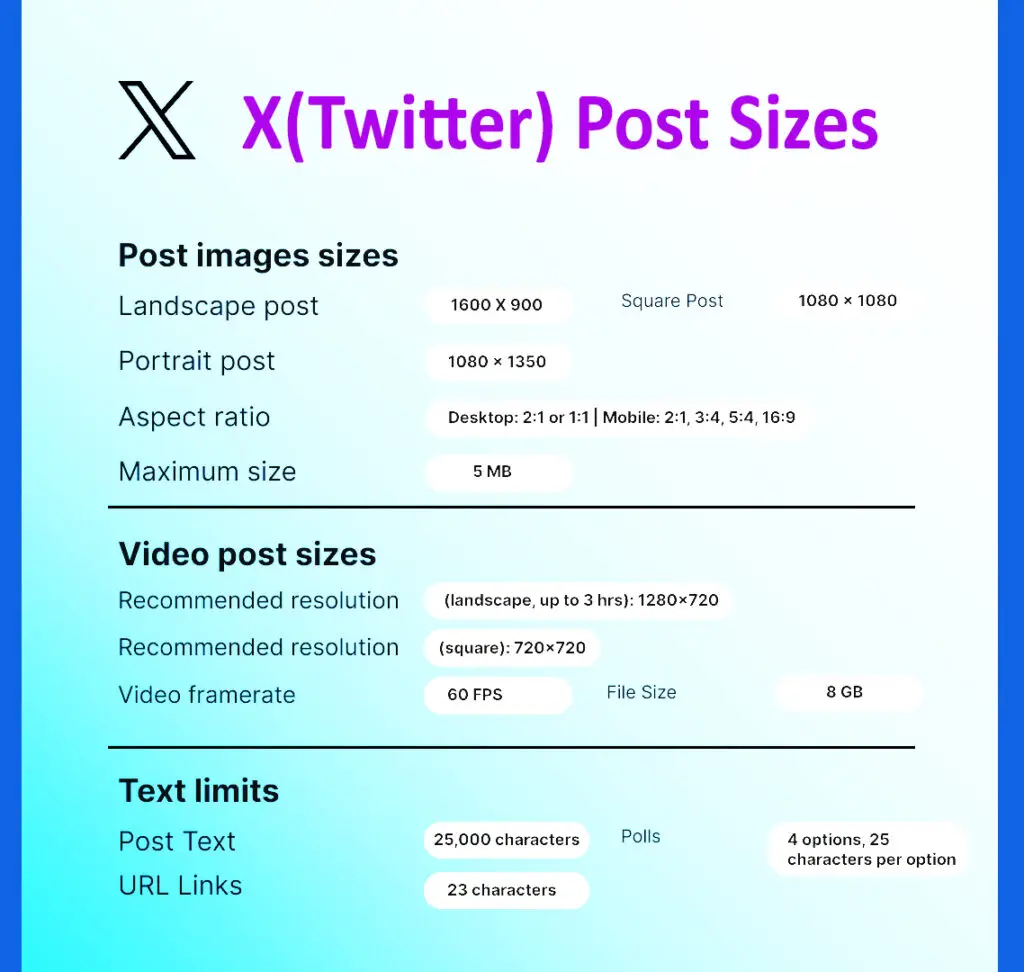
X has transitioned from microblogging to long-form, visual-first content. With 650 million active users, it’s still the pulse of real-time news.
Image Sizes
- Landscape: 1600 x 900 pixels
- Square: 1080 x 1080 pixels
- Portrait: 1080 x 1350 pixels
Video Sizes
- Landscape: 1280 x 720 pixels
- Square: 720 x 720 pixels
- Max File Size: 8 GB
- Max Length: 140 seconds (standard users); up to 3 hours (Blue subscribers)
- Frame Rate: 60 FPS
Text Limits
- Post Text: Up to 25,000 characters
- Poll Options: 25 characters max each, 4 options
- Links: Always counted as 23 characters
Tips: Use bold, short headlines with clear CTAs. Images boost retweets by up to 150%. X still prioritizes engagement over length.
Snapchat Post Sizes in 2025
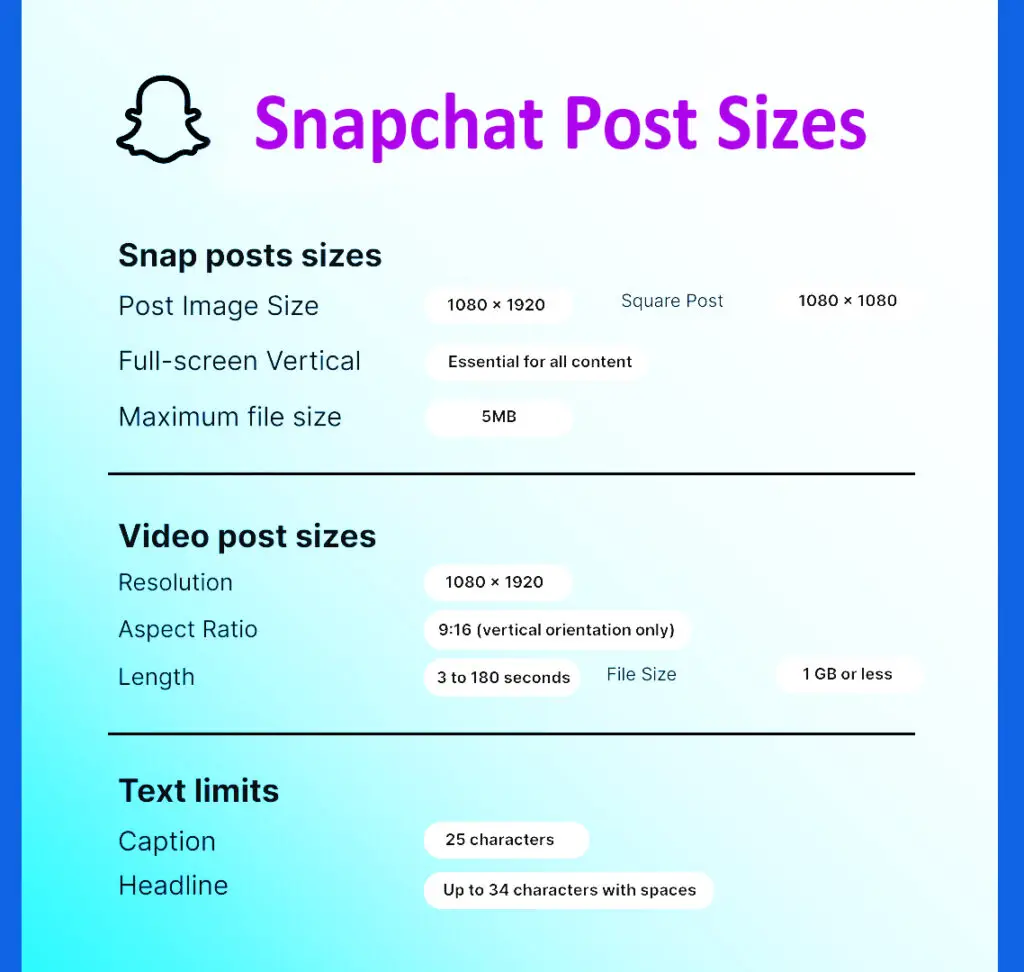
Snapchat remains dominant for Gen Z and younger millennials, with ephemeral content in vertical formats and over 850 million users.
Image Sizes
- Full-Screen Post: 1080 x 1920 pixels (9:16)
- File Size Limit: 5 MB
Video Sizes
- Resolution: 1080 x 1920 pixels
- Max Length: 3 minutes per Snap (if file < 1 GB)
- File Size: Up to 1 GB
Text Limits
- Caption: 25 characters
- Headline: 34 characters (including spaces)
Tips: Keep content real and spontaneous. Snapchat’s Discover feed prefers raw storytelling and short, impactful messaging.
TikTok Post Sizes in 2025
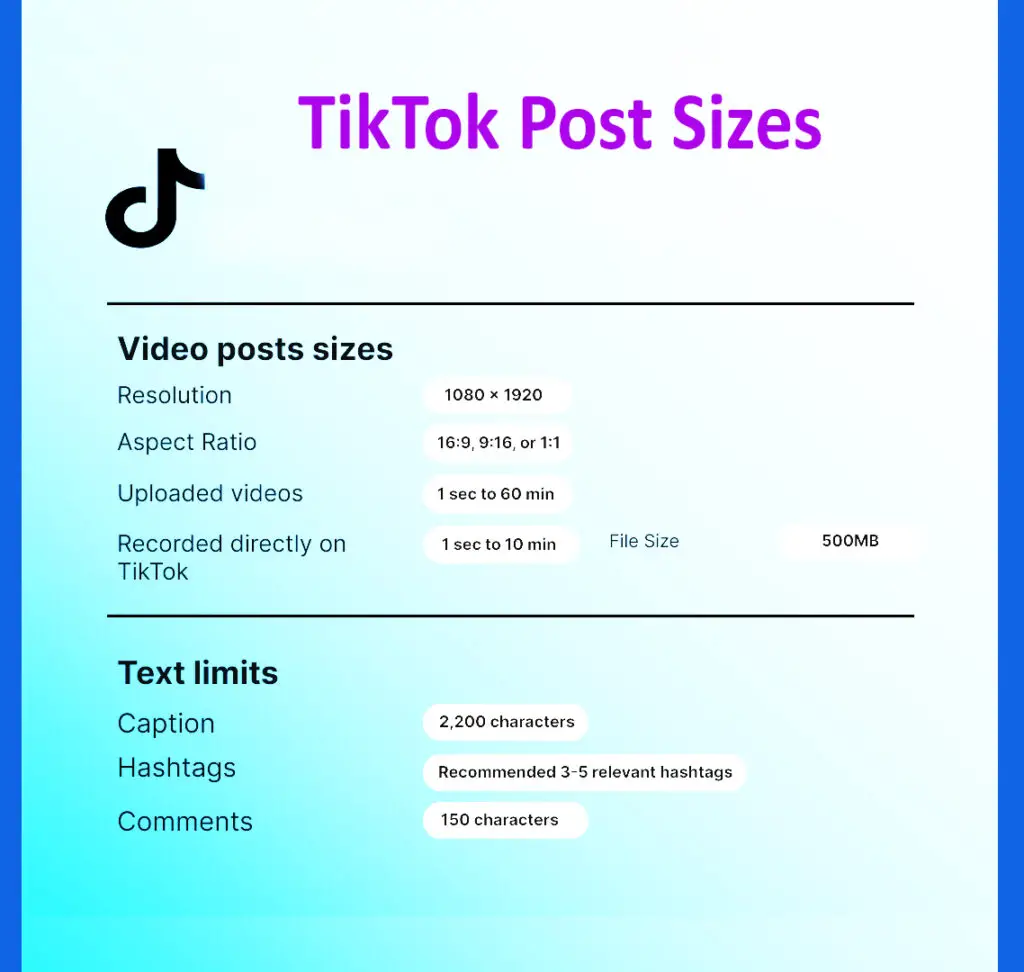
TikTok has evolved into a multi-format platform with long-form uploads and a growing professional creator economy. It now has over 1.12 billion monthly active users.
Video Sizes
- Resolution: 1080 x 1920 pixels (16:9 or 9:16)
- Aspect Ratios: 9:16 (full screen), 1:1, 16:9
- Max Length:
- In-app recordings: Up to 10 minutes
- Uploaded videos: Up to 60 minutes
- Max File Size: 500MB
Text Limits
- Caption: 2,200 characters
- Hashtags: Recommended 3–5 relevant hashtags
- Comments: 150 characters
Tips: Strong hooks in the first 3 seconds are critical. Use on-screen captions and trending audio for algorithm boosts.
BlueSky Post Sizes in 2025
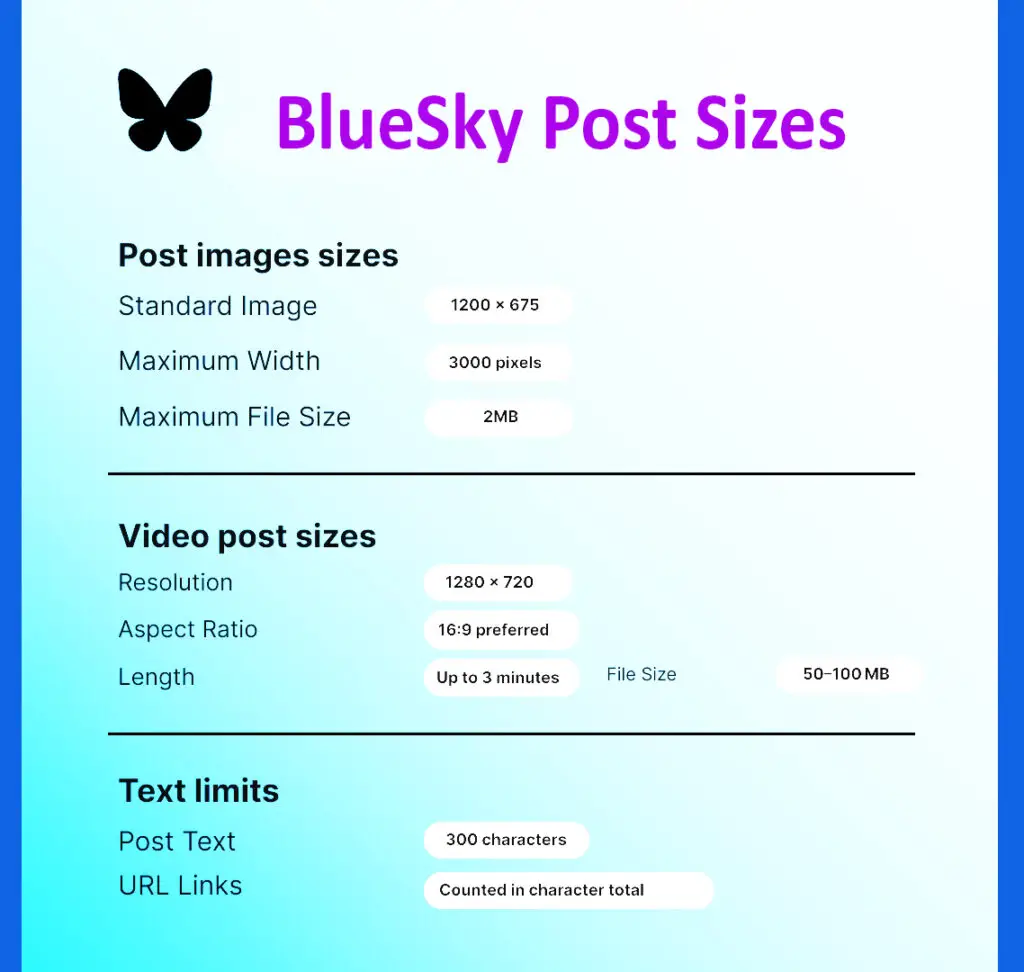
BlueSky, a decentralized social app, is growing rapidly and is projected to reach 84 million users by late 2026.
Image Sizes
- Standard Feed Image: 1200 x 675 pixels (16:9)
- Max Width: 3000 pixels
- Max File Size: 2MB
Video Sizes
- Resolution: 1280 x 720 pixels
- Max Length: 3 minutes
- File Size: 50MB to 100MB
Text Limits
- Post Text: 300 characters
- Links: Counted within character limit
Tips: BlueSky emphasizes conversation quality over reach. Ideal for communities, open discourse, and chronological feed lovers.
Pinterest Post Sizes in 2025
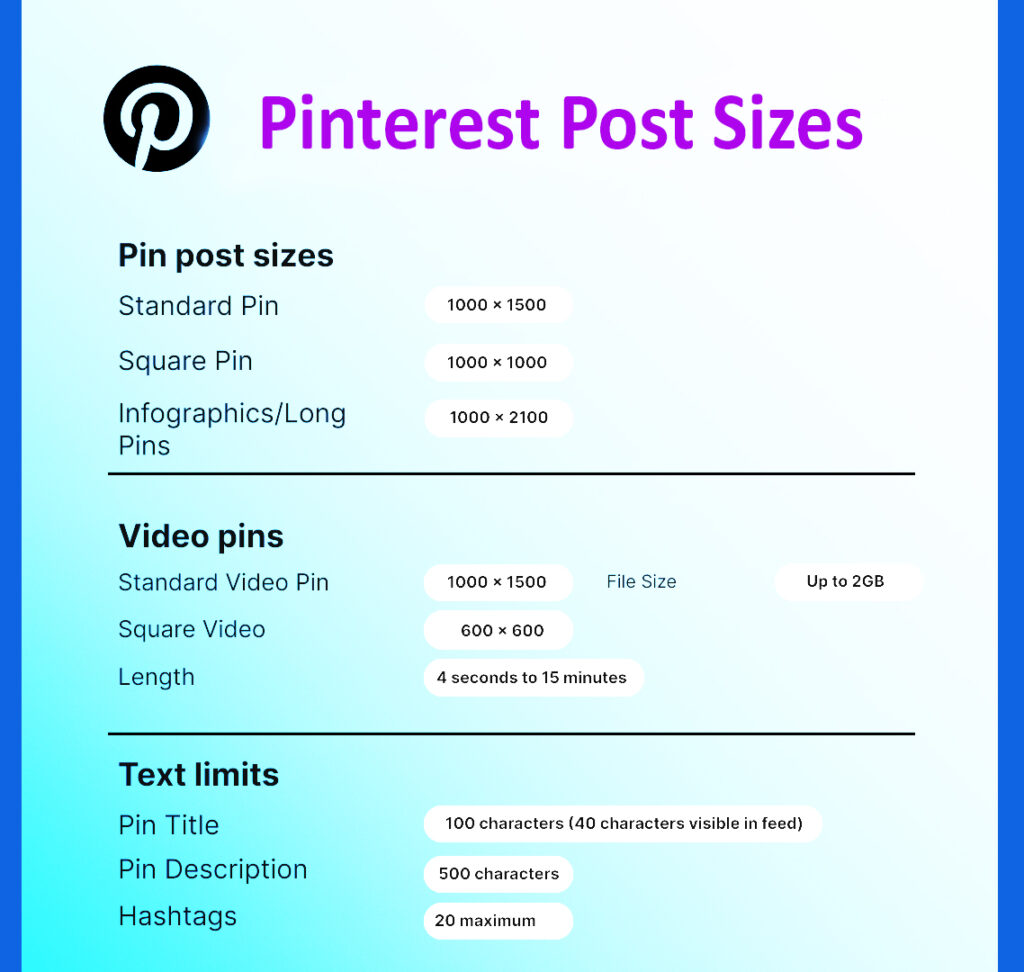
Pinterest operates like a visual search engine. With 453 million active users, it offers unmatched evergreen content visibility.
Image Sizes
- Standard Pin: 1000 x 1500 pixels (2:3)
- Square Pin: 1000 x 1000 pixels
- Long Pin/Infographic: 1000 x 2100 pixels max
Video Sizes
- Standard Video Pin: 1000 x 1500 pixels
- Square Video: 600 x 600 pixels
- Length: 4 seconds to 15 minutes
- File Size: Up to 2GB
Text Limits
- Pin Title: 100 characters (40 visible)
- Description: 500 characters
- Hashtags: Up to 20 (optimized: 3–5 focused tags)
Tips: Vertical content dominates. Pins with clear call-to-action overlays and keyword-rich descriptions increase saves and traffic.
YouTube Post Sizes (2025)
YouTube isn’t just for long-form video anymore—it’s now a major player in short-form content, community engagement, and visual branding, with over 2.7 billion active users. Creators must optimize every element, from video thumbnails to Shorts, for better visibility and engagement.
Video Sizes
- Standard YouTube Video (16:9): 1920 x 1080 pixels (Full HD)
- Vertical Video (Shorts – 9:16): 1080 x 1920 pixels
- Square Video (1:1): 1080 x 1080 pixels
- Aspect Ratios Supported: 16:9 (default), 1:1, 4:3, 9:16
- Minimum Resolution: 426 x 240 pixels
- Max File Size: 256 GB or 12 hours in length
Thumbnail Sizes
- Optimal Size: 1280 x 720 pixels
- Minimum Width: 640 pixels
- Aspect Ratio: 16:9
- File Size Limit: 2MB
- Formats Supported: .JPG, .GIF, .BMP, or .PNG
Text Limits
- Video Title: 100 characters (70 recommended for display)
- Description: 5,000 characters
- Tags: Up to 500 characters
- Community Post Text: 1,000 characters
YouTube’s algorithm prioritizes watch time and click-through rates, so eye-catching thumbnails and well-sized, high-resolution videos are essential. For Shorts, vertical video is a must.
Threads Post Sizes (Meta’s Twitter Alternative)
Threads, Meta’s microblogging platform connected to Instagram, is gaining momentum with over 160 million downloads globally. Its minimal interface and fast-paced conversations require sharp visuals and concise messaging.
Image Sizes
- Image Post Size: 1080 x 1350 pixels (portrait)
- Square Format: 1080 x 1080 pixels
- Landscape Format: 1200 x 628 pixels
Video Sizes
- Aspect Ratio: 9:16, 1:1, 16:9
- Resolution: 1080 x 1920 pixels preferred
- File Size Limit: 100 MB
- Length Limit: Up to 5 minutes
Text Limits
- Text Length: 500 characters
- Links: Clickable and counted in character limit
- Image/Video per Post: Up to 10 media files
Threads focuses on real-time interactions and shares cross-promotion advantages with Instagram. Visuals should be crisp and instantly understandable for mobile-first audiences.
WhatsApp Channels Post Sizes
WhatsApp Channels, a relatively new broadcast tool under the Meta ecosystem, is built for one-to-many communication with a growing presence in over 150 countries.
Image Sizes
- Recommended Size: 1080 x 1920 pixels (portrait, similar to Stories)
- Aspect Ratio: 9:16
- Supported Formats: JPG, PNG, GIF
Video Sizes
- Max File Size: 2 GB
- Recommended Resolution: 1080 x 1920 pixels
- Length Limit: Up to 3 minutes (for maximum engagement)
Text Limits
- Text Message Length: 4,096 characters
- Captions for Media: 1,024 characters
This feature works best with short, clear updates and attention-grabbing visuals. Since channel messages don’t allow direct replies, you must engage viewers through consistency and compelling multimedia.
Tips for Optimizing Post Sizes in 2025
Whether you’re a brand or a creator, here are universal tips to make the most of your social media visuals and text limits:
1. Design Mobile-First
Most users access content via smartphones. Vertical formats (especially 9:16) dominate platforms like TikTok, Instagram Reels, Snapchat, and YouTube Shorts.
2. Stick to Recommended Sizes
Oversized or undersized visuals may get cropped or appear blurry. Use platform-specific guidelines for optimal appearance.
3. Use Templates
Design tools like Canva and Adobe Express offer pre-sized templates for each platform—saving you from resizing headaches.
4. Optimize File Sizes
Large files may take longer to load or be rejected. Compress videos and images without compromising quality.
5. Keep Text Concise
Although some platforms offer generous character limits, shorter posts with strong CTAs or emotional hooks often perform better.
Beyond Dimensions: Best Practices for High-Impact Social Media Posts in 2025
While using the correct image dimensions is essential for social media success, it’s only the starting point. The real magic happens in how you use that space to captivate, convert, and connect. Let’s break down the top strategies to amplify your impact across platforms in 2025 — beyond just size.
1. Understand What Visually Resonates With Your Audience
It’s not enough to know your audience’s age or interests — you need to know what visuals they actually engage with. Visual preferences differ across platforms and demographics:
- B2B audiences on LinkedIn gravitate toward full-width visuals (1200 x 627 px) that feature clean data graphics or professional charts.
- B2C followers on Instagram prefer portrait-style images (1080 x 1350 px) that feature real-life, relatable content over polished ads.
Study your engagement metrics across post formats. Tech audiences may prefer square-shaped infographic posts, while lifestyle or fashion followers are drawn to full-screen vertical visuals. Customize accordingly.
2. Design with Dimension in Mind
The size of your content should align with the type of message you’re delivering:
- Use larger vertical formats (like Pinterest’s 1000 x 1500 px) for complex or detailed visuals.
- Keep text readable even when scaled down on mobile devices.
- Upload high-resolution images — ideally double the required resolution — to ensure clarity on high-definition displays.
- Build custom templates for each platform’s preferred post dimensions to streamline your content creation process.
In 2025, resizing the same graphic won’t cut it. Creating original content for each platform is the new standard for serious brands.
3. Tailor Captions to Platform Limits
Your visual gets them to pause, but your caption makes them stay. Each platform has different rules of thumb for caption length:
- X (formerly Twitter): Although it allows up to 25,000 characters now, concise posts under 100 characters see the highest engagement.
- Instagram: Stick to 125 characters or less upfront for key messages — the rest is hidden behind a “more” link.
- LinkedIn: Thought leadership posts between 1,000–1,500 characters tend to generate the most meaningful interactions.
- Facebook: Keep it short and sweet. Posts under 80 characters perform best despite the massive 63,000+ character limit.
On mobile — where most users browse — less is more.
4. Use Hashtags With Precision, Not Overload
Hashtags can supercharge discoverability, but only when used strategically per platform:
- Instagram: 3–5 targeted hashtags > using all 30 allowed.
- LinkedIn: Stick to 2–3 industry-relevant hashtags.
- X: One or two timely hashtags aligned with trending conversations works best.
- TikTok: Use 3–5 popular and niche hashtags for better placement in algorithmic feeds.
- Facebook: Hashtags have minimal impact. Use only when extremely relevant.
Copy-pasting your hashtag strategy across platforms is a fast track to lower engagement.
5. Make Your CTAs Visible and Click-Worthy
A strong CTA (call to action) only works if people see it. Placement should align with each platform’s layout and viewing patterns:
- Instagram square posts (1080 x 1080): Center your CTA to grab focus.
- Facebook rectangular posts (1200 x 630): Place CTAs in the lower right — the natural endpoint of most reading paths.
- TikTok vertical videos (1080 x 1920): Keep CTAs in the middle third of the screen to avoid clashing with captions and buttons.
- X landscape images (1600 x 900): Position CTAs on the right-hand side for best click-through performance.
Test different placements frequently to see what drives the best results.
6. Stay Consistent Across Formats
Brand consistency across formats strengthens recognition and trust:
- Build content calendars that account for platform-specific dimensions.
- Keep fonts, color schemes, and logos visually consistent—even across different post sizes.
- Post regularly and at optimal times for each channel.
- Ensure your mix of stories, reels, and static posts align with your brand’s overall identity.
7. Engage Like a Native on Each Platform
How you interact with your audience should feel natural to the platform’s environment:
- Instagram: Engage through threaded replies to encourage ongoing conversations.
- LinkedIn: Craft thoughtful responses that add professional insight.
- X: Be witty, concise, and relevant in real-time interactions.
- TikTok: Use humor, trends, and creator-friendly language when replying to comments.
One-size-fits-all engagement feels robotic. Platform-specific responses build community.
8. Track Performance by Format Type
Your KPIs (Key Performance Indicators) should change based on content type:
- 9:16 vertical video: Prioritize completion rate and replays.
- 1:1 Instagram square posts: Focus on likes, shares, and saves.
- LinkedIn thought leadership posts: Monitor comment quality and meaningful discussions.
- Facebook link previews (1200 x 627): Track click-through rate (CTR) and conversions.
Use platform analytics to see what works, then double down on your top-performing dimensions.
9. Keep Your Brand Voice Consistent Across Formats
No matter the format, your tone should always reflect your brand’s identity:
- Don’t water down your messaging to fit format constraints.
- Tweak tone for the platform while staying true to your voice (e.g., more relaxed on Instagram, more formal on LinkedIn).
- Use native features authentically — don’t shoehorn content meant for one platform into another.
- Behind-the-scenes content is great for brand personality—just ensure it’s sized right for each channel.
Brands that perform best in 2025 are those that adapt format while staying unmistakably themselves.
10. Stay Flexible as Platforms Evolve
Social platforms change constantly — your content strategies should too:
- Stay updated on every platform’s latest specs and format changes.
- Refresh your templates whenever new dimensions are introduced.
- Embrace new media types early to gain first-mover advantage (think of how Reels took off in early 2020s).
- Use flexible design systems that scale across post types and screen sizes.
In 2025, agility is just as important as creativity.
Final Thoughts
In 2025, social media platforms are more competitive and algorithmically complex than ever. Native content, tailored dimensions, and character optimization all influence reach and engagement. By mastering these dimensions and staying updated, marketers and creators can ensure their posts stand out visually and algorithmically.
Use this guide in combination with your analytics tools to A/B test what performs best for your audience on each platform. Tailored content equals higher performance!

